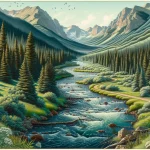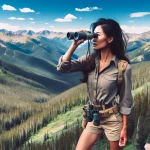The Colorado River, beginning in Rocky Mountain National Park and winding its way through the rugged landscapes of the American Southwest, offers an unparalleled kayaking experience. With its diverse array of rapids, calm stretches, and breathtaking scenery, this iconic waterway attracts kayakers from around the world.
In This Article
TL;DR
- The Colorado River provides many kayaking experiences, from tranquil flatwater to exhilarating whitewater rapids.
- Essential gear and safety precautions are crucial for a safe and enjoyable kayaking adventure on the Colorado River.
- Seasonal variations in water levels and weather conditions impact the kayaking river trip experience, making it essential to plan accordingly.
Exploring the Colorado River: A Kayaker’s Paradise
The Colorado River’s geographic and hydrologic diversity contributes to its appeal as a premier kayaking destination. From its headwaters in the Rocky Mountains to its terminus in the Gulf of California, the river offers a multitude of kayaking opportunities. Some key locations are Kremmling, where the Blue River joins the Colorado; Dotsero, where the Eagle River joins; Glenwood Springs, where the Roaring Fork River meets; and Grand Junction, where the Gunnison River joins the Colorado River.
The Geographic and Hydrologic Diversity of the Colorado River
The Colorado River spans over 1,450 miles, traversing through seven U.S. states and two Mexican states. Its course includes iconic landmarks such as Cataract Canyon, Black Canyon of the Gunnison, and the Grand Canyon. The river’s flow and volume vary significantly along its length, influenced by snowmelt, rainfall, and dam operations.
Planning Your Kayaking Adventure: What You Need to Know
Before embarking on a Colorado River kayaking adventure, obtaining the necessary permits and familiarizing yourself with the regulations is essential. Guided tours or independent kayaking each offer unique advantages and considerations.
Necessary Permits and Regulations for Kayaking on the Colorado River
Certain sections of the Colorado River require recreational use permits, particularly in national parks and wilderness areas. These permits help manage visitor numbers and protect the river’s ecosystem. Regulations may also vary depending on the specific location and time of year.
Essential Gear and Safety for Kayaking on the Colorado River
Proper gear and safety measures are crucial for a safe and enjoyable kayaking experience on the Colorado River. The river’s varying conditions demand specific equipment and preparedness.
Must-Have Kayaking Gear
- Kayak: Choose a kayak suitable for the river's conditions, such as a whitewater kayak for rapids or a touring kayak for flatwater sections.
- Personal Flotation Device (PFD): A properly fitted and Coast Guard-approved PFD is mandatory for all kayakers.
- Paddle: Select a paddle appropriate for your kayak type and intended use.
- Safety gear: Essential items include a whistle, throw bag, and first-aid kit.
Navigating the Waters Safely
- Be aware of potential hazards like strainers, undercut rocks, and low-head dams, and know how to navigate them safely.
- Check weather and water conditions before launching, and be prepared to adjust your plans accordingly.
- Never kayak alone; always inform others of your planned route and expected return time.
Seasonal Considerations for Kayaking on the Colorado River
The Colorado River’s kayaking conditions are heavily influenced by seasonal weather patterns and water levels, making it essential to plan your trip accordingly.
Best Times of Year for Kayaking
- Spring: Snowmelt from the Rocky Mountains can create high water levels and exciting whitewater conditions, particularly in the upper Colorado River.
- Summer: Lower water levels and warmer temperatures make for ideal flatwater kayaking conditions in many sections of the river.
- Fall: Cooler temperatures and moderate water levels can provide a comfortable kayaking experience, especially in the river's lower reaches.
Environmental and Conservation Concerns
As stewards of the Colorado River, kayakers play a vital role in preserving its natural beauty and ecological integrity. Responsible practices and eco-friendly kayaking can help minimize environmental impact.
The Role of Kayakers in Preserving the Colorado River’s Natural Beauty
- Practice Leave No Trace principles by properly disposing of waste and minimizing disturbance to the river's ecosystem.
- Respect wildlife by maintaining a safe distance and avoiding disturbance to their habitats.
- Support conservation efforts and organizations that protect the Colorado River and its surrounding areas.
Enhancing Your Kayaking Experience
To take your Colorado River kayaking adventure to the next level, consider advanced techniques, training opportunities, and engaging with the local kayaking community.
Advanced Techniques and Training for Kayakers
- Attend workshops and courses offered by experienced instructors to improve your skills and learn advanced techniques.
- Practice techniques like eddy turns, ferrying, and river reading to navigate challenging sections of the river more confidently.
Community and Resources
- Join local kayaking clubs and groups to connect with fellow enthusiasts, share knowledge, and participate in kayak tour outings.
- Utilize online resources and forums to plan your trips, seek advice, and stay updated on river conditions and regulations.
Beyond Kayaking: Complementary Outdoor Activities
While kayaking is the main attraction, the Colorado River and surrounding areas offer many other outdoor activities to complement your adventure.
Other Water Sports and Activities on the Colorado River
- Tubing: Enjoy a leisurely float down the river's calmer sections on an inflatable tube.
- Rafting: Experience the thrill of navigating rapids on a guided or self-guided whitewater rafting trip.
- Stand-up paddleboarding (SUP): Explore the river's flatwater sections while standing on a paddleboard.
Land-Based Adventures Near the Colorado River
- Hiking: Embark on scenic hikes along the river's banks or nearby canyons and national parks. Glenwood Springs is popular because it has hot springs along the banks of the Colorado River.
- Camping: Set up camp and immerse yourself in the natural beauty of the Colorado River region.
- Wildlife watching: Look for the diverse flora and fauna that call this area home.
FAQ
How do I obtain the necessary permits for kayaking on the Colorado River?
Permit requirements vary depending on the specific location and managing agency. Permits can often be obtained through online reservation systems or visitor centers for national parks and wilderness areas. It’s essential to plan ahead and secure permits well in advance, especially during peak seasons.
What should I do if I encounter wildlife while kayaking?
Maintain a respectful distance from any wildlife you encounter and avoid disturbing their natural habitats. Do not approach or feed animals; be prepared to alter your course if necessary. Observe and appreciate wildlife from a safe distance.
Can I kayak on the Colorado River year-round?
While kayaking is possible year-round on certain sections of the Colorado River, conditions can vary significantly depending on the season and location. Spring and early summer typically offer higher water levels and more challenging whitewater conditions, while late summer and fall may have lower water levels more suitable for flatwater kayaking.
Are there any age or skill level restrictions for kayaking on the Colorado River?
Age and skill level restrictions may apply in certain areas, particularly for whitewater sections or guided tours. Checking with the managing agency or tour operator for specific requirements is essential. Generally, beginner-friendly sections, such as Glenwood Canyon, are suitable for most ages and skill levels. More challenging stretches, like Gore Canyon, may require prior experience or specialized training.






